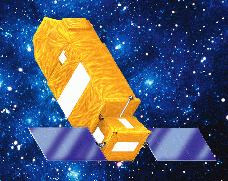

Mission Status Report #53 Star Date: January 15, 2002
Strides Toward Recovery!Caption: FUSE Science Operations have been on hold since Dec. 10, 2001, while we troubleshoot a problem with our pointing system. The report below provides an update on our progress. (Click image above to see larger version.)
Hello World, I am happy to report that the last month has seen considerable progress toward recovering science operations with the FUSE satellite. The anomaly we experienced on December 10, 2001, involved the Reaction Wheels, as described in my previous report. On December 20th, we uplinked a software patch provided by the spacecraft vendor, Orbital Sciences Corporation. This patch brought the magnetic torquer bars (MTBs) into the attitude control loop (at least in a crude way) for the first time and provided modest stability in the otherwise uncontrolled "yaw" axis of motion. It was extremely gratifying to be in the Satellite Control Center and watch the yaw axis spin rate decrease almost immediately upon activating the patch! After coming to a halt, we performed a slew to a safe and reasonably stable attitude, and "parked" the satellite there while the next steps were prepared. By monitoring the satellite in this orientation, we gained significant insight into the "disturbance environment" of the satellite and modelled the observed disturbances in preparation for the steps to come. Since January 2, we have made several slews to keep the satellite pointed near the pole of the orbit. This is predicted to be the most stable attitude, and our experience confirms this prediction. (The pole moves, or precesses, and so we have to move the pointing to "keep up" with it.) We have also studied the reaction wheel problem in detail and begun activities to try and spin the errant reaction wheel. This activity is perhaps trickier than you might assume. We want the wheel to spin, but if it starts spinning it could easily move our pointing direction toward the sun-side of the orbit, which would be dangerous. Hence, we have had to build logic into the control system that would recognize if the wheel starts spinning and take corrective action to control the satellite even while allowing the errant wheel to keep spinning. (Nothing is easy in the space biz.) So far attempts to spin the wheel have been unsuccessful, but we will keep trying! Since it is possible that the reaction wheels will remain uncooperative, we are pursuing other options as well. Refined control software that redefines the operational axes of the satellite and controls with both reaction wheels and MTBs is in testing. As soon as it is fully tested, we will uplink this new control software and start testing on the "real bird." While it may take awhile to get our detectors turned back on and checked out, and understand our new observing and pointing constraints, we are hopeful that we will be back on line and taking science data in the not too distant future. Thanks to all the scientists and engineers who have been (and are) working so hard to make this all come together. On another front, the winter American Astronomical Society meeting was held last week in Washington DC. It was a spectacular meeting for FUSE results! Over 50 presentations involving FUSE data were made over the four days of the meeting, and FUSE banners were everywhere! I've said it before, but it is great for those of us on the Operations team to see so much coming out scientifically! One significant result, the discovery of a "corona" around our Milky Way galaxy, is summarized HERE! Also, see our Press Page [no longer active] for links to recent articles on-line about FUSE results, including some from the AAS meeting.
Reported by: Bill Blair, Chief of Observatory Operations
For more information, contact NASA Project Scientist George Sonneborn (george.sonneborn@gsfc.nasa.gov).
|
